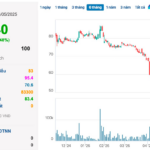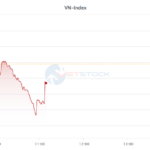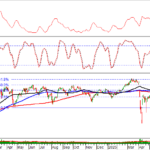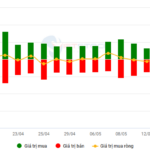After a relentless rally that saw the VN-Index surpass the 1,309-point mark, the benchmark finally faced profit-taking pressures. The index closed the week’s final trading session almost 12 points lower, retreating to just above 1,300. The large-cap VN30 suffered a more severe loss, plunging by 17.05 points to land at 1,384.
This development is understandable, given that the market’s recent growth was driven by large-cap stocks in the banking and real estate sectors, which took turns leading the charge over the past week. Notably, banks witnessed an average decline of 1.76% today, with major pillars suffering more considerable drops: VCB by 2.04%, BID by 2.14%, CTG by 1.89%, VPB by 2.7%, and VIB by 2.4%.
Commenting on the market’s current phase, Mr. Nguyen The Minh, Director of Research and Analysis at Yuanta Securities, attributed the sharp decline to three primary reasons.
Firstly, after the VN-Index’s robust ascent beyond 1,309 points, the market showed signs of weakening. The first indication was the performance of mid-cap and small-cap stocks, which lost momentum last week. The market’s upward trajectory was predominantly propelled by large-cap stocks, primarily in the real estate and banking sectors. When the breadth of the rally narrowed, focusing on these large-cap groups, it signaled that the market’s strength was waning, and risks were gradually emerging.
Secondly, the market experienced a dip in early April due to US President Donald Trump’s tariff actions, followed by a recovery. Many stocks have since delivered handsome profits, reaching up to 15%, making them susceptible to profit-taking pressures.
Currently, the VN-Index hovers around the 1,300 level, reminiscent of early April when investors were blindsided by Trump’s tariff announcement. A significant number of investors were trapped in this zone, and if they failed to act on April 3, they are now likely to offload their positions to reach safer shores, wary of potential negative developments.
Thirdly, the market rebound fully reflected the temporary tariff reprieve granted by the US to other countries. Investors now await the official outcome of the tariff negotiations. During this waiting period, profit-taking and market exits are likely to occur.
Technically, many stocks have entered a deeply overbought state. “The market requires a corrective phase to establish a more sustainable upward trajectory,” Mr. Minh asserted. “The upcoming tariff rounds will likely generate more intense negotiations and market volatility.”

According to Yuanta’s Director of Research and Analysis, in the next 1-2 weeks, the market will start receiving information related to the negotiation rounds between the US and other countries. These developments will likely trigger further market fluctuations.
Identifying new buying opportunities in this zone is challenging, as investors are generally cautious about stocks susceptible to tariff impacts, such as industrial parks, exporters, and transportation companies. While these sectors might not be directly affected at present, the tariff situation remains a wildcard. The risk associated with these sectors is rising, and any gains are likely to be short-lived, as witnessed in the previous phase.
Sectors unaffected by tariffs, such as banking and real estate, have already witnessed substantial increases. In the real estate sector, the listing of Vinpearl’s VPL shares has concluded. In the banking sector, attention has been on select stocks expected to increase their foreign ownership limits to 49% on May 19, while the overall performance has been uneven. As the sector moves in stock-specific trends, it will not reflect the collective health of the industry. This segment will likely undergo a corrective phase before resuming its upward trajectory.
Mr. Minh presented two scenarios for the VN-Index. In the first scenario, if a substantial volume of shares becomes available for trading next week, the market could witness a deep correction, with the index retreating to the 1,250-1,280 range. The second scenario involves a large volume of shares becoming available but without a sell-off, leading to a sideways market for the week.
Regarding the foreign investors’ net sell-off of nearly VND 1,000 billion in today’s session, Mr. Minh refrained from drawing conclusions about their trend. He observed that this could be new capital from foreign investors returning to Vietnam after exiting the US market. Therefore, he expects this group to continue net buying in the coming period.
“FPT Group’s Impressive Cash Dividend: A Whopping 100% Payout!”
The FOC stock is currently trading at VND 82,600 per share on the stock exchange, surging approximately 18% over a month. This marks a significant recovery from its early April lows of VND 56,000, representing a near 50% ascent from those levels.
Market Pulse, May 15: Real Estate Pressures Mount, But Banking Sectors Come to the Rescue
The VN-Index demonstrated its resilience in the face of morning pressures, with the critical 1,300 level providing excellent support as buying interest emerged. The index rebounded to close at 1,313.2 points, a gain of 3.47 points. The contrasting performances of the two large-cap sectors, banking, and real estate, were the highlight of the session.
Technical Analysis for May 15: Supply Pressure Mounts
The VN-Index and HNX-Index both witnessed a decline, and with no significant improvement in liquidity during the morning session, it indicates a prevailing sentiment of uncertainty in the market.
Stock Market Update for Week of May 12-16, 2025: Pausing the Uptrend
The VN-Index ended the week on a negative note, halting its four-day winning streak. In the coming weeks, the index is likely to face challenges as volatility persists around the 1,300-point mark. If the index can hold firm above this threshold and foreign investors maintain their net buying trend, the short-term uptrend is expected to continue.











![[Photo Essay]: Experts, Managers, and Businesses Unite to Forge a Path Towards Sustainable Green Industry](https://xe.today/wp-content/uploads/2025/07/z678592918-150x150.jpg)


![[Photo Essay]: Experts, Managers, and Businesses Unite to Forge a Path Towards Sustainable Green Industry](https://xe.today/wp-content/uploads/2025/07/z678592918-100x70.jpg)






